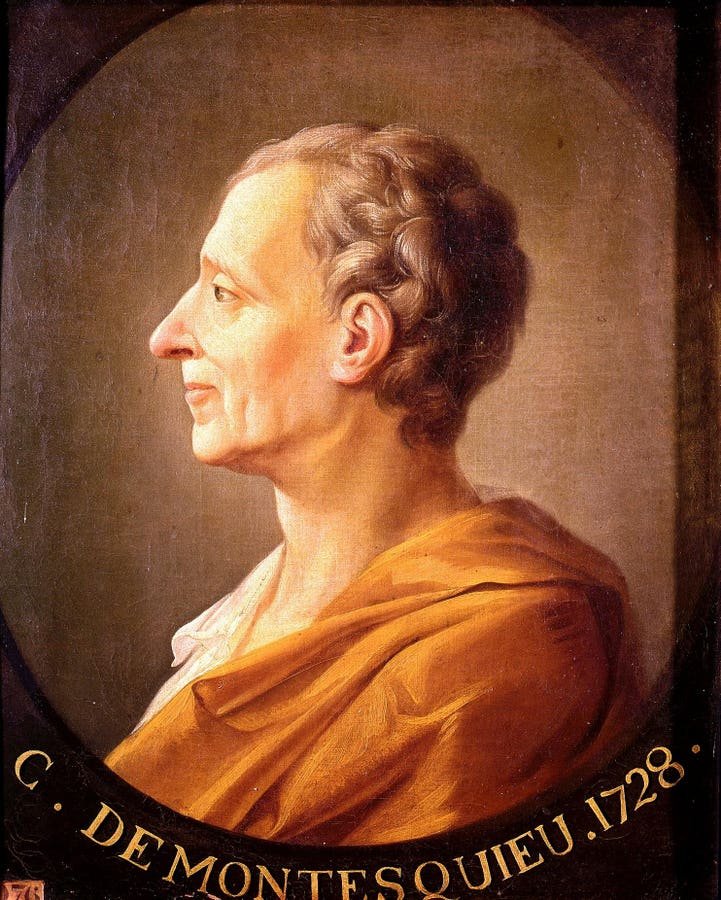We should put him on a coin (Photo by Roger Viollet Collection/Getty Images)
Roger Viollet via Getty Images
A few years ago I wrote a piece, for Public Discourse, called “Montesquieu and the Monetary System.” It discussed our having fiat money, non-gold-standard money, today, from the perspective of the eighteenth century French legal sage, Montesquieu. His Spirit of the Laws argued that legal arrangements properly well up from the ethos of the people—that there should be little “space” between what laws and legal conventions specify and the actual desires of the populace about the ordering of society.
Fiat money fails this test outright. The public abhors fiat money and yearns for the days when the all-American expression “sound as a dollar” meant something. The United States was on the gold standard until 1971, and minted silver coins until 1964, these dates marking the final points of the most longed-for period of all of American economic history, in the popular imagination today—that of postwar, post-World War II prosperity. Americans prefer today, as they always have, classical monetary systems, not fiat ones.
The view of experts is the opposite. They think that fiat money is great, and that the gold standard in particular is properly in the dustbin of history. They reject returning to a gold standard outright, get impatient with entertaining objections, and point to overwhelming consensus among professionals and specialists in monetary affairs that any consideration of the gold standard today is a waste of time, resources, and energy. Ben Bernanke’s position that he had no idea what moved the gold markets encapsulated the matter. A chief monetary master, such as a Federal Reserve chair, perhaps above all else should have a view as to what moves the gold markets.
Populace loves gold-standard-like money, experts dismiss such money, and that is the situation we have. It is a very nice illustration of what Montesquieu was getting at. The public wants something, but its legal conventions give it something else. Therefore—something has to give.
You can say Bitcoin. We certainly do in our new book, Free Money: Bitcoin and the American Monetary Tradition, in which we make the case that the entire monetary history of the United States has momentum in one direction, toward classical money. Because we did away with classical money, in time came an approximation of it, Bitcoin.
But there are other ways, just as important, that the public preference for classical money manifests itself. I submit that the entirety of the housing affordability crisis stems from this preference. As I discussed several weeks ago, the Case Shiller home-price index, which begins its run in the nineteenth century, was all but flat for the seventy-five years before the bust-up of the gold standard circa 1970. To reduce the matter:
Home prices in the United States were always low and stable—until we went off the gold standard in 1971.
Since that event, Case-Shiller has leapt and leapt. There has been some retracement here and there, but in general, the index has gone up. Prior to 1971, stable; post, 1971, up.
The search for alternative causes is not necessary. Housing and land are classical hedges against fiat money. There are other factors in total average home prices—property taxes—but even building materials in important cases (such as copper) themselves have significant hedge characteristics against fiat money. Land is a hedge against non-geological (gold) money. We went off gold, and we had a boom in that which bases a house, land, and therefore in houses.
It is not so much that houses have become unaffordable as the portfolio preference of the country has shifted towards real estate, and away from other constituents of total assets, the whole division much different from if we had a classical monetary system. Stock ownership has behaved the same way, as I have written about on various occasions. Stocks have monetary and tax hedge characteristics. Buying them en masse has essentially only been taking place since the 1920s—which is to say after the imposition of the Federal Reserve and the income tax in 1913.
The efficiency loss to the economy in having huge portfolio preference shifts because the money convention is not what the public wants is necessarily large. We have had two percent growth at best in the whole of the 21stcentury. This is half, at best, what was normal throughout American history. The 1970s were an economic dumpster fire. Gold fell in the markets in the 1980s and the 1990s, as real estate calmed down for once. Then we had great real economic growth.
When we have had a simulacrum of a gold standard since 1971—the 1980s and 1990s—house prices have calmed their appreciation and volatility. When we have not—the 1970s and 2000 to today—we have housing bubbles and the occasional bust as a matter of course.
Bitcoin will probably indeed come to save us from fiat money, and thereby restore normal portfolio preferences across the board, including in real estate. In the meantime, the professional monetary class could get serious about respecting the pointer from Montesquieu. We have fiat money, but the public hates it. Therefore, professional class, you should begin discovering good cogent reasons, complete with models and algebra, to find it badly wanting too. And if your expertise is telling you otherwise, it is fooling you.

